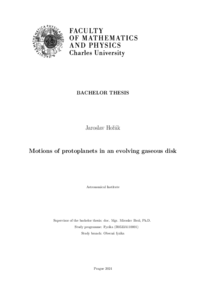Pohyby protoplanet ve vyvíjejícím se plynném disku
Motions of protoplanets in an evolving gaseous disk
bachelor thesis (DEFENDED)

View/
Permanent link
http://hdl.handle.net/20.500.11956/193808Identifiers
Study Information System: 256460
Collections
- Kvalifikační práce [11326]
Author
Advisor
Referee
Vokrouhlický, David
Faculty / Institute
Faculty of Mathematics and Physics
Discipline
Physics
Department
Astronomical Institute of Charles University
Date of defense
11. 9. 2024
Publisher
Univerzita Karlova, Matematicko-fyzikální fakultaLanguage
Czech
Grade
Excellent
Keywords (Czech)
protoplanetární disk|sluneční soustavaKeywords (English)
protoplanetary disk|Solar SystemTitle: Motions of protoplanets in an evolving gaseous disk Author: Jaroslav Hořák Institute: Astronomical Institute Supervisor: doc. Mgr. Miroslav Brož, Ph.D., Astronomical Institute Abstract: Planets form from protoplanets orbiting young stars, when gaseous disk still exists. This gas gravitationally interacts with protoplanets, alongside mutual perturbations between protoplanets. This phenomenon is known as planetary migration. Our aim is to investigate the role of planetary migration, specifically, in the context of the terrestrial planets (Mercury, Venus, Earth, Mars). This has been studied previously with a stationary prescription for migration and without simulating the evolution of the disk (Brož et al. 2021). Instead, in this work we use formulae for migration torque based on actual profiles of the evolving disk. We used an N-body symplectic integrator to describe motions of protoplanets (Duncan et al. 1998). Evolution of the gas disk was modeled by 1-D hydrodynamics, considering turbulent viscosity and magnetically-driven disk wind (Suzuki et al. 2016). Migration torques were computed according to Paardekooper et al. (2011), from actual profiles of the disk. Moreover, our model included close encounters, collisions of protoplanets (merging), mutual resonances, eccentricity and inclination...
Title: Motions of protoplanets in an evolving gaseous disk Author: Jaroslav Hořák Institute: Astronomical Institute Supervisor: doc. Mgr. Miroslav Brož, Ph.D., Astronomical Institute Abstract: Planets form from protoplanets orbiting young stars, when gaseous disk still exists. This gas gravitationally interacts with protoplanets, alongside mutual perturbations between protoplanets. This phenomenon is known as planetary migration. Our aim is to investigate the role of planetary migration, specifically, in the context of the terrestrial planets (Mercury, Venus, Earth, Mars). This has been studied previously with a stationary prescription for migration and without simulating the evolution of the disk (Brož et al. 2021). Instead, in this work we use formulae for migration torque based on actual profiles of the evolving disk. We used an N-body symplectic integrator to describe motions of protoplanets (Duncan et al. 1998). Evolution of the gas disk was modeled by 1-D hydrodynamics, considering turbulent viscosity and magnetically-driven disk wind (Suzuki et al. 2016). Migration torques were computed according to Paardekooper et al. (2011), from actual profiles of the disk. Moreover, our model included close encounters, collisions of protoplanets (merging), mutual resonances, eccentricity and inclination...
